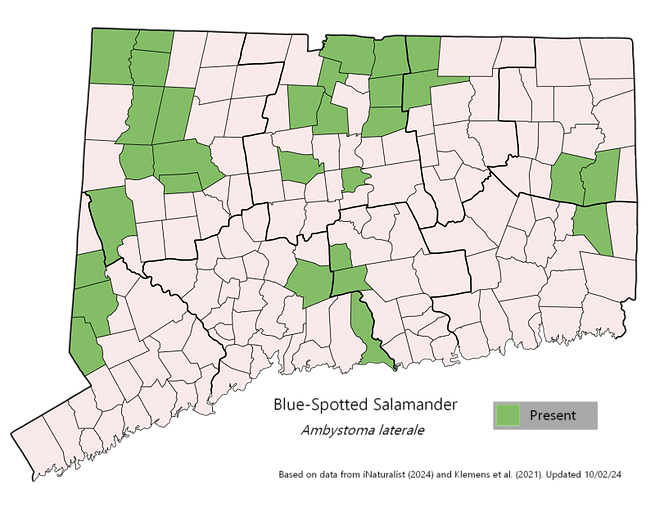Blue-spotted Salamander
Ambystoma laterale
Conservation Status:
State Status: Critically Imperiled (NatureServe, 2025)
State Listing: Endangered (DEEP, 2015)
Global Assessment: Least Concern (IUCN, 2020)
Description
Blue-spotted salamanders can grow up to 8 inches long (Watkins-Colwell, 2025). They are black in color and have blue or white speckling across the body. Specks can range in size and quantity. These salamanders have pale bellies, stocky bodies, and wide heads. A laterally flattened tail is also prominent.
Habitat
This species spends a majority of its life underground in burrows. They can be found in moist deciduous forests and wetlands.
Behavior
Blue-spotted salamanders eat a variety of invertebrates such as worms, slugs, and insects. They generally only come to the surface during breeding season, which occurs in the early spring. On rainy nights they migrate to vernal pools. Females lay egg masses in the water, which hatch into aquatic larvae. When threatened, these salamander will raise their tails and release a toxin (Quinn, 2020). This species is known to hybridize with the Jefferson salamander.
Range


Blue-Spotted Salamander
Photographed by Cody Limber
Often Confused with

Jefferson Salamander
Photographed by stevejr
Telling these two species apart is difficult due to the amount of hybridization between them. Hybrids may obtain characteristics from both species, causing confusion. Blue-spotted salamanders have larger spots that appear more blue in color when compared to those of the Jefferson salamander. Blue-spotted salamanders have slightly more narrow heads than Jefferson salamanders.

Blue-Spotted Salamander
Photographed by Cody Limber
Often Confused with
Northern Slimy Salamander
Photo needed! Email ajones7428@gmail.com
Slimy salamanders have cylindrical tails and their spots are white. Blue-spotted salamanders have blue spots, and a laterally flattened tail. When threatened, slimy salamanders will secrete a sticky, glue-like secretion that is hard to remove from hands and fabric.
References
Department of Energy and Environmental Protection. (2015, August 5). Endangered, Threatened, and Special Concern Amphibians. Connecticut. https://portal.ct.gov/deep/endangered-species/endangered-species-listings/endangered-threatened--special-concern-amphibians.
iNaturalist. (2024). Observations. California Academy of the Sciences / National Geographic Society. https://www.inaturalist.org/observations?place_id=49&taxon_id=52354.
International Union for Conservation Of Nature and Natural Resources. (2020, December 18). Blue-spotted Salamander. https://www.iucnredlist.org/species/59060/193226221.
Klemens, M. W. et al. (2021). Conservation of Amphibians and Reptiles in Connecticut. Department of Energy and Environmental Protection. https://ctdeepstore.com/products/conservation-of-amphibians-reptiles-in-connecticut.
NatureServe. (2025, January 31). Ambystoma laterale. https://explorer.natureserve.org/Taxon/ELEMENT_GLOBAL.2.102149/Ambystoma_laterale.
Quinn, D. P. (2020). Blue-spotted Salamander. Connecticut Herpetology. https://www.ctherpetology.com/blue-spotted-salamander-complex.
Watkins-Colwell, G. J. (2025). Blue-spotted Salamander - Ambystoma laterale. Yale Peabody Museum. https://peabody.yale.edu/explore/collections/herpetology/guide-amphibians-reptiles-connecticut.
Page updated February 1, 2025
